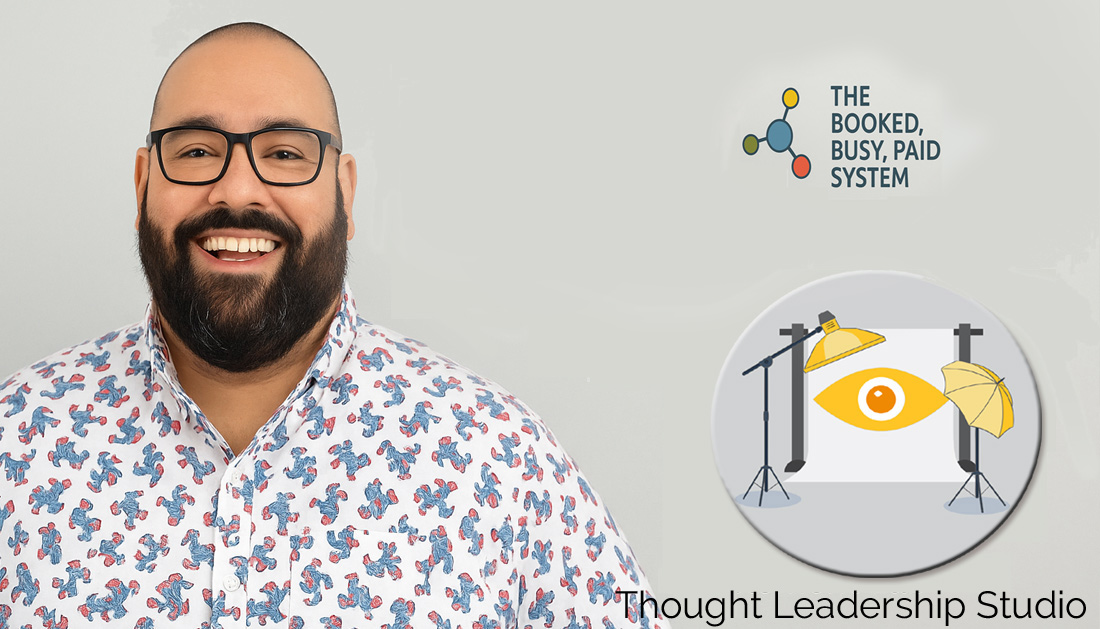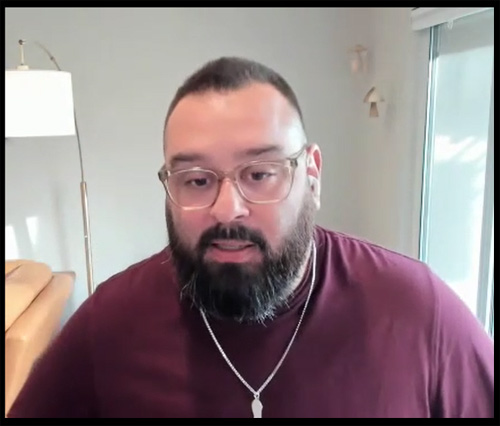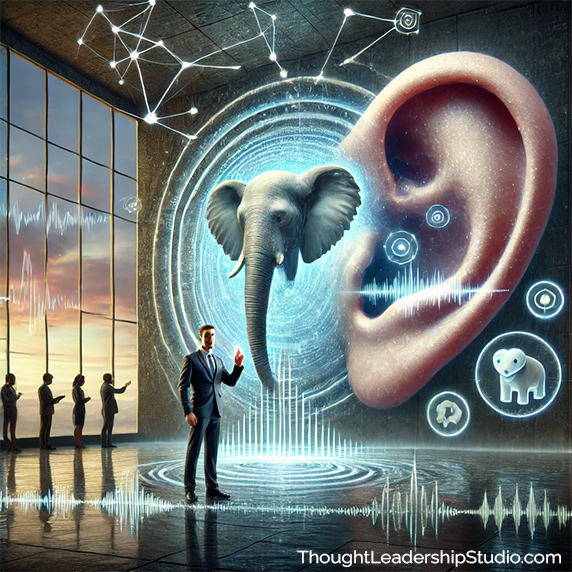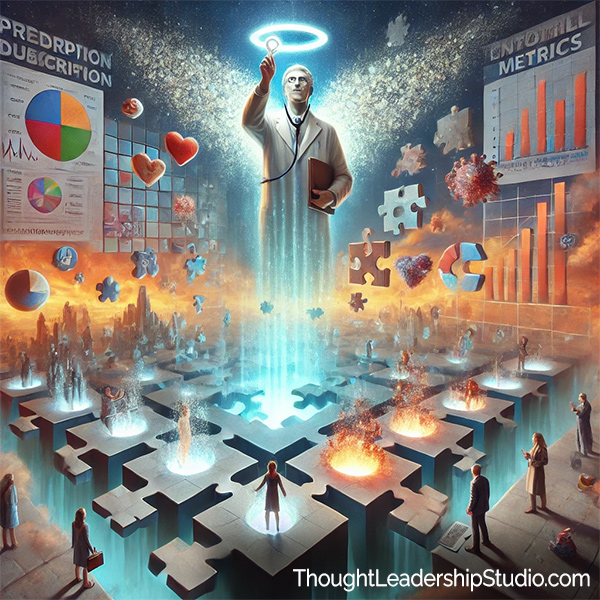Thought Leadership Studio Podcast Episodes:
Strategic Revenue Alignment with Luis Baez
Episode 100 – Scaling with Integrity: How to Align Messaging, Teams, and Customer Experience for Sustainable Growth and Thought Leadership Impact

#coaching, #consulting, #customerexperience, #entrepreneurship, #influence, #interview, #leadership, #linkedin, #management, #marketing, #marketingstrategy, #sales, #scalingbusinessgrowth, #systemsthinking, #tesla, #thoughtleadership
Or Click here to listen or subscribe on appWhat this episode will do for you
:- Discover Luis Baez’s Revenue Enablement Journey: Learn how Luis pivoted from leadership roles at LinkedIn, Google, Uber, and Tesla to coaching and consulting with a focus on uplifting people, systems, and sales performance.
- Understand the Power of Customer-Centric Strategy: Explore why listening to the customer’s voice is essential—and how it can reshape internal alignment, messaging, and revenue growth.
- Learn to Align Teams Around What Matters: Get practical insights on translating tech-heavy or feature-based messaging into language that resonates emotionally with your market.
- Avoid the Trap of Scaling Dysfunction: Discover the importance of proper diagnosis before growth—and how to spot misalignment in marketing, sales, and operations before it bottlenecks success.
- Connect Strategic Thought Leadership to Revenue Growth: See how STL applies to sales and ops by leading internal and external audiences with clarity, empathy, and value-driven influence.
Luiz Baez.
In this episode, I’m joined by Luis Baez - revenue enablement strategist, sales coach, and LinkedIn Learning instructor whose work bridges influence, integrity, and implementation.
Strategic Thought Leadership is about guiding others to fresh, well constructed perspectives with clarity and purpose. Luis applies this principle by helping companies scale not just revenue, but alignment—connecting sales, ops, and marketing around the customer’s actual voice.
With experience at Tesla, LinkedIn, Google, and Uber, Luis shares how to avoid scaling dysfunction, how to align messaging to real customer needs, and how to lead with listening. His practical, holistic approach brings STL into revenue strategy—making growth more human and more effective.
Some of Luis's coordinates:
Curated Transcript of Interview with Luis Baez
The following partial transcript is lightly edited for clarity - the full interview is on audio. Click here to listen.
Chris McNeil: So I'm your host of Thought Leadership Studio, Chris McNeil, and today I'm excited to be speaking with Luis Baez, a revenue enablement strategist and sales coach with experience at LinkedIn, Google, Uber, and Tesla.
I think we know some of these company names.
Luis now helps business leaders scale the revenues and influence sharing his expertise at top business schools like Stanford and UC. Berkeley as a published author and LinkedIn learning instructor, his teachings on personalized sales have reached over 20,000 people. Great to have you here, Luis.
 Luiz Baez: Thank you for having me, Chris. I appreciate you.
Luiz Baez: Thank you for having me, Chris. I appreciate you.
Chris McNeil: As we were discussing before we started, I love the positioning of a revenue enablement strategist as well as sales coach. How'd you come up with that term?
From Corporate Ladder to Purpose-Driven Revenue Growth
Luis Baez: Revenue enablement is a practice, a career pivot that I made in my corporate career. I reached a point where I realized being chief revenue officer wasn't the ambition. I really enjoyed as a sales leader developing my salespeople and I leaned into coaching and training. What I learned is that there are companies that have entire functions called revenue enablement, and these are folks that really accelerate the velocity to revenues through training, certification, operations, and implementing the right sort of tools.
And so I've been in that world for the last seven years in the corporate world, being director of global revenue enablement at a startup, but then also as a consultant stepping into businesses and looking at where we can make magic at that intersection of marketing, sales and operations.
 Chris McNeil: So there's a pivot point, so maybe to give the listener a little context on your story and where you're coming from in case they're not already familiar with you and we'll be getting familiar through the podcast. What was that pivot point? What happened that set you on this path?
Chris McNeil: So there's a pivot point, so maybe to give the listener a little context on your story and where you're coming from in case they're not already familiar with you and we'll be getting familiar through the podcast. What was that pivot point? What happened that set you on this path?
Luis Baez: Yeah. I was a sales leader at Tesla and I was managing a region across North America, over a hundred people on the team. And I thought that that was what I wanted in terms of the way that I envisioned myself as a leader was climbing the ladder and ascending to that level of influence as a chief revenue officer.
And so I thought I needed to be a sales manager step into VP down the line and then CRO down the line. But when I reached that level of experience, I realized that my secret sauce and the thing that also lit me up was being able to develop those people around me and to uplift their capacity and productivity and ultimately drive results for the company's bottom line through revenue.
And I started to do some of that work on the side. I've always been a side hustler, and so I've always been consulting and coaching and I started stepping into small businesses and online businesses and looking at how do we scale revenues instead firmly seven figures and above. What are the operations sort of processes that need to be in place, who needs to be in place, sort of trainings that need to be delivered, the skills that need to be upleveled?
And I started doing that work and it really lit me up. So I stepped away from corporate and I poured myself into that.
Chris McNeil: So what's your vision for what you're doing now? If you could wave the magic wand and create any results you wanted for the world and for yourself, what would that look like?
Luis Baez: I want to see as many business leaders thrive as possible. I know that entrepreneurship is a really lonely process, and as far as mental health goes, the in suicide rate is quite high. And so what I want is for people to get the sort of training and sort support and confidence that they need through the revenue performance and everything else so they have oxygen, right? There are so many businesses and business leaders that deserve to thrive.
And so I have stepped into this capacity through coaching and consulting on my own and supporting businesses. In this vein, I also work with an accelerator that supports women owned businesses, and I'm also on the advisory board of an AI tech company. And so the way that I sort of put my tentacles out in the world now is all in the vein of helping businesses sustain their revenues.
Fueling Founders: Giving Entrepreneurs Oxygen to Thrive
Chris McNeil: So helping businesses sustain the revenues. I love what you said about helping entrepreneurs have oxygen, the acknowledgement that it's a lonely path and sometimes have a coach or a consultant, and I'm in that role sometimes myself.
It's one person they can really open up to in some cases and articulate what's going on in their heads and externalize it and get some leverage there. And I love that you work with both the people and the operation side because if you just work on the people side but the processes aren't good, they can be restricted.
Luis Baez: Yes. It needs to be that holistic approach. Indeed.
 Chris McNeil: Absolutely. So what does it do for you, most importantly, to do this kind of work to see that these founders, these entrepreneurs have oxygen and to help them thrive?
Chris McNeil: Absolutely. So what does it do for you, most importantly, to do this kind of work to see that these founders, these entrepreneurs have oxygen and to help them thrive?
Luis Baez: Yeah, I think about the sort of impact that we could have in this world if everyone had an opportunity at serving and upleveling. I think about how communities can flourish if they had the sort of customer experiences and they had the supportive businesses and leaders that really upheld their quality of life and their wellbeing.
I also think about what's happening in the world today and how entrepreneurship can help to solve and alleviate some of the ways that people are being left behind. I think about the sort of engine that we can create economically by bolstering and supporting a community of entrepreneurs that serve at a certain level and degree.
And for me, this vein of work is in line with the sort of superhero that I always wanted to be when I was a kid. Batman was my jam. I wanted to be a Bruce Wayne. I wanted to be that very discreet billionaire, investing in all the things that help the people while also moonlighting as someone that is a total rebel and a technologist because I love the gadgets and that has always been the sort of spirit that drives me is that I want to be that sort of superhero that uses money in this way and creates capital and creates opportunity and community in this way.
Chris McNeil: Absolutely. And some people dis on capitalism, but it's all about intent, isn't it? There can be enlightened capitalism and using it as a force to do good. And so what are the leverage points that you look for?
I'm thinking about the listener who might have a small business media, maybe either C-suite and a large business, or maybe they're starting a business, and to have the opportunity to pick your brain a little bit as a revenue enablement strategist and sales coach. When you first go into a project, what kind of questions do you ask that might also be helpful to the listener in those situations?
Luis Baez: Yeah. When I'm stepping into a project and I am thinking about assessing what's the state of the state, what is the mindset and the sort of collective energy in the business that is holding the progress back, right?
Reading the Room: Reconnecting Leaders with Their Customers
Chris McNeil: Read the room a little bit.
Luis Baez: We need to read the room because here's the thing, we can look at numbers all day long. I can run the numbers and you've had the capacity to run the numbers on your end, so where they're headed. What I need to understand when I'm stepping into a room and I'm working with leaders and stepping into my capacity as the revenue enablement practitioner, the first thing I ask leaders is, when is the last time you spoke to a customer?
When is the last time you sold your product or service, and what sort of hesitations did you have to overcome and where was the friction in onboarding the customer and making sure that they had success in working with you?What I try to diagnose is do you really have your finger on the pulse or have you been sitting behind and delegating all the things? Because you need to understand the lifeline of your business, and that is the customer's voice.
And if you don't have the capacity be on calls, then you need to implement a revenue intelligence tool like Gong or Chorus that listens to calls and analyzes them and can feed intelligence to you about the customer's voice, but I need you to tell me where is the customer's experience falling off? Then we can reverse engineer that from an operational standpoint in sort of plugging all the holes in the processes, and then we can support that process operationally with the right training and certification and upleveling of skills of the people through training and coaching.
Chris McNeil: Love that. And there's nothing that can substitute for firsthand knowledge of the customer transaction point and when the decision, this is my experience, and stop me if they see another perspective to add please.
 When there are decisions being made, several hierarchies away from the customer contact that's pushing distortions into the system to prevent the customer from getting what they want. So do you find that leaders are surprised at the discoveries they make when you start studying this? Do you bring them in to look at it firsthand in addition to using these tools?
When there are decisions being made, several hierarchies away from the customer contact that's pushing distortions into the system to prevent the customer from getting what they want. So do you find that leaders are surprised at the discoveries they make when you start studying this? Do you bring them in to look at it firsthand in addition to using these tools?
Luis Baez: Yeah, I think the first hurdle I've got to overcome is that after I asked that question, a lot of folks are quite upset with themselves red in the face about the fact that they haven't listened to a customer call in a while and they haven't sat with a customer. They're not aware of that voice.
So I've got to overcome that sort of emotional and mindset sort of blockage immediately by assuring them that there's a solution for this and there's a process and a framework for this. Then I've got to spell out the steps, right? Because typically when I step in, it's like we're going to do a needs analysis.
I need to see what the numbers look like. I need to read any customer reviews that exist online or anywhere else. I need to sit with those people who serve the customers in different capacities, whether they are customer support, marketing or direct salesperson.
I need to sort of figure out, they're all describing the elephant to me, but one group is describing the trunk, the other group is describing the floppy ear. Another group is describing the belly, and so I've got to assess the elephant from all angles, and then I step in with all the feedback, all the numbers and everything.
Let's develop a strategy. Let's look at getting the kinks out of the customer's experience. Then let's look at getting the messaging aligned between marketing and sales. Then let's look at the delivery of that message across collateral and the way that calls are conducted with customers. And with every layer of the onion,
I'm ultimately arriving at a place where all of these teams internally are all speaking to one another in a productive way. Externally, it's a frictionless experience for the customer. And then as far as the bottom line, seeing the lift in sales and revenue,
Prescription Without Diagnosis Is Malpractice in Business, Too
Chris McNeil: Love it. And especially the time in effort you put into the diagnosis before writing the prescription.
Luis Baez: Yes.
Chris McNeil: I think we can easily, as consultants and coaches, mis-presdribe if we haven't done the right level of diagnosis.
Luis Baez: Yeah, I think the thing that I come up against is that people want an accelerated diagnosis, and so they want me to step in having known all the things and being ready to write the prescription, but there needs to be a process of gathering intelligence, and that gathering takes two to four weeks, truly if someone is doing it with the right due diligence, taking the time to look at the quantitative and the qualitative inputs before then arriving out of recommendation.
Chris McNeil: So as someone who's done similar enough gigs, and I know a lot of our listeners are in that boat too with the consulting and coaching, sometimes you work one on one, sometimes you go into a company, do you find resistance as per, "Oh, we already know our customer. Oh, we already know this stuff."
That kind of resistance. And if you do, how do you deal with it? Do you filter that out before you take a customer.
Luis Baez: I think the first thing that we do in an instance like that, it's like, okay, well first of all, let's admit that there's something that we're missing. Otherwise I wouldn't be in the room having this conversation with you.
And so let's just take a moment and let's just be very honest and let's just take a moment to when was the last time we surveyed customers? When was the last time we surveyed internally? Where are the gaps in data? Where are the gaps in the capacity for listening? Where are the cliffs in the customer experience as well? And so I always like to pull at assumptions first. I always like to pull at what's working as well, and then we come back and reverse engineer from what's not working, because every business will tell you, every business leader will tell you that they always want more revenues.
 And when I think about solopreneurs and sidepreneur and small business owners in particular, I've been talking about navigating spaces with multiple departments, these smaller businesses. One person is every department, and that also requires a bit of compartmentalization. When I approach a smaller business and say, okay, so let's look at what your marketing strategy has been. Let's look at where we need to delegate and hire, and let's look at where the sales and the revenues performance has been. Is it time to bring in someone to support you with business development? Let's get someone in place.
And when I think about solopreneurs and sidepreneur and small business owners in particular, I've been talking about navigating spaces with multiple departments, these smaller businesses. One person is every department, and that also requires a bit of compartmentalization. When I approach a smaller business and say, okay, so let's look at what your marketing strategy has been. Let's look at where we need to delegate and hire, and let's look at where the sales and the revenues performance has been. Is it time to bring in someone to support you with business development? Let's get someone in place.
Let's train them up on your messaging and how it is that you communicate with the customer, get someone else filling your calendar so that you have more oxygen to increase capacity in other areas of the business. If you can get someone humming on sales, then you can start to focus more closely on your operations and the customer experience and getting the kinks out of your automations and such.
And so there is a way to get this all done. And typically what I like to do is I have this sort of business order of operations. I call it my boo, and I'd like to personify it. It's my boo. I love my boo. I check in with my boo all the time. My boo is my guide. Because what I do in my monthly and quarterly planning and outlook is I compartmentalize everything into four quadrants product. You have to have something to sell, and you need to make sure that it drives whatever promise you have associated with it.
Sales, when you have something to sell, you got to have a process for selling it. So let's look at what that looks like, and if you don't have a process, let's get one in place. Then I look at operations. Once you start selling things, you need to have the things in place to fulfill your sales, right? Automations have to fire off, things have to be fulfilled, access have to be granted, et cetera.
When you've got all those things in order and you have check, check checked, all those boxes, then I look at marketing, then we look at the fun stuff because your backend is good to go, right? Then we look at running campaigns, jumping on podcasts, looking at any sort of partnerships or speaking opportunities or anything in that vein that helps to amplify the visibility of your business.
Don’t Scale Dysfunction—Diagnose Before You Accelerate
Chris McNeil: Sure. We certainly don't want to scale up dysfunction. So addressing those issues about serving the customer ahead of doing things to exponentially grow and bring in more customers.
How do you gather this information? Do you set up observation situations or are you doing it primarily through interviews or a combination - or what else is involved in that?
Luis Baez: Yeah, typically if I'm stepping into an organization that has some sort of revenue or customer intelligence or a CRM of the sort, I'd like to look at the numbers, show me your performance over the last 30 days, over the last 90 days, and then over the last 12 months, I'd like to see any sort of trends in the seasonality of your business.
 I'd like to also, as you give me stories and anecdotes about what happened throughout that year, I want to be able to match that up with the way that it impacted performance in your business so that I can start to deduce the correlation of things with the sort of hunches deductions and hypotheses.
I'd like to also, as you give me stories and anecdotes about what happened throughout that year, I want to be able to match that up with the way that it impacted performance in your business so that I can start to deduce the correlation of things with the sort of hunches deductions and hypotheses.
I then go through a round of interviews and you sort of do a exploratory conversation with those folks that are involved in revenue performance, whether they sit in marketing, operations, all the levels of sales, anyone that somehow influences the customer's thinking or the customer's experience.
And I really try to understand from their purview what's working, what's not, where's the disconnect? How do you engage with these other departments? What's the frequency of your engagement? What's the quality of it? And then after I do all of that sort of analysis, then I'm sitting with the numbers, I'm sitting with the anecdotes, I'm looking at the campaigns, sort of assessing the quality of the content and the experience in front of the customer.
I'm going in and I'm clicking around from the customer's point of view, and I'm taking my notes and I'm coming back to the table and I'm saying, this is your diagnosis. This is where the problem lies. This bone is not connected to that bone. This automation isn't in place or firing off as it should. Also, the customer isn't asked this question at any point in their journey, therefore, you're missing out an opportunity for upsells, renewals, et cetera, right? I help them see where the holes are in that entire journey, and then here's your plan 30, 60, 90 days out. This is how we start to transform everything beyond this sort of assessment that I've done.
From Strategy to Execution: The Consultant’s Dual Role
Chris McNeil: Do you see the role of the consultant in these situations as also in implementation and being involved in the plan coming fully into place?
And if so, how do you do that? How do you arrange those situations?
Luis Baez: Yeah. I think that if you are in a position where you're invited to collaborate at that level of not only providing the strategic oversight, but actually being involved in implementation, that is a matter of understanding and planning for capacity on your end, making sure that either you or someone that you can bring on board or subcontract or hire is someone that can help you implement the things, build the things, create the things within the timeline and within the budget that's been negotiated, and that is a matter of really also understanding capacity.
Some solopreneurs want to remain solopreneurs, and so their timelines might be elongated when they're working on projects or they only take one client at a time, and therefore want to make sure that they're implementing minimum investment thresholds, so it is worth their time. You don't want to burn yourself out by overdelivering and undercharging.
Chris McNeil: Sure. Absolutely understand, and of course, the theme of this podcast is Strategic Thought Leadership. It's about messaging. It's about leading an audience to embrace new perspectives that in the context of sales and organizational development, favor the USPS of the company as well as empowering the audience to get more value out of that category.
I'm seeing a lot of threads that you're putting out here that we could dive into on that topic. One of them being, how do you get everybody in the organization on the same sheet in terms of messaging?
Luis Baez: Yeah. I think that that starts with a real, again, gathering of intelligence and understanding the customer voice. You don't want to, I've seen so many instances, particularly with tech companies, that's been my foray for the last almost two decades, and when I look at the way that they try to introduce solutions to consumers, their messaging in their positioning is entirely too focused on capabilities, features, memory, capacity, and all this sort of jargon that doesn't align with the way that the user is thinking day to day.
 And so simple example of that is looking at the way that companies sell smartphones. They could sell their smartphone by emphasizing gigabytes of ram, how fast the visual processor is, how much it is capable of this and that, right? You can emphasize a thousand technologies that are under the hood, but the way that they market to consumers is, look what this can do.
And so simple example of that is looking at the way that companies sell smartphones. They could sell their smartphone by emphasizing gigabytes of ram, how fast the visual processor is, how much it is capable of this and that, right? You can emphasize a thousand technologies that are under the hood, but the way that they market to consumers is, look what this can do.
It can take pretty pictures. It helps you keep in touch with Nana. It helps you book that Uber because that is the language that the customer speaks. They're not worried about how many giga flops are under the hood. You figure that out. That's what you're hired for. What I want to know is if I give you $1,500 for this phone, will it take the best selfies possible?
So in that same vein, when you're thinking about connecting with your customers, you want to, or when you're thinking about aligning your messaging across your teams and connecting with your customers and upleveling that, make sure that you step in and really look at the ways that all the teams are speaking to the customer, and then help translate marketing, speak to customer speak sales, speak to customer speak, right?
Let's look at the tech features and the tech stack, and then let's look at the results and the outcome for the customers that are using it, it's capable of X, Y, or Z. What does that mean for you? You save time on this process. You save money in this way. And so that I think is the most important thing is when stepping into an organization and trying to align all the messaging, let me understand how each team speaks to the customer. Let's help refine all the things and then get on the same page about what matters to the customer and how we should be thinking internally.
***************************************
The transcript is lightly edited for clarity and is a partial transcript- the full interview is on audio. Click here to listen.
***************************************
Free Stuff and Offers Mentioned in Podcast
***************************************
***************************************